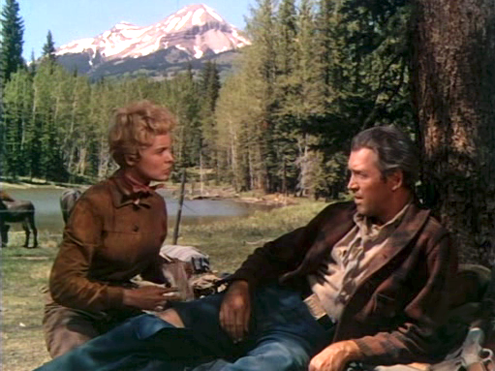
by Ed Howard
Another filmmaker with a distinctly moral perspective in his films was Anthony Mann, the premier stylist of the American Western. The Naked Spur is the third entry in Mann’s run of Westerns starring James Stewart, probably the best run of Westerns ever to come out of Hollywood. Mann’s hard-edged look at the American frontier, and his unconventional conception of the Western “hero” — the quotes were often required for Mann’s leads — found their perfect realization in Stewart. In Mann’s films, he inevitably positioned Stewart’s character as a morally ambiguous, distanced figure acting out of self-interest rather than any moral imperative. Here, Stewart plays a former rancher who was betrayed by his girlfriend and lost his land. In order to get it back, he becomes a bounty hunter, tracking down a murderous local outlaw (Robert Ryan) in order to bring him in for a reward. Along the way, Stewart unwillingly takes on two partners, an amiable old gold-seeker (Millard Mitchell), and a corrupt ex-cavalryman (Ralph Meeker). When the trio manage to capture Ryan (and his companion, Janet Leigh), the outlaw begins playing them off each other, awakening instincts for greed, lust, and hatred in the three men.As far as the narrative goes, Mann’s construction is as always taut and engaging. This is the second time I’ve seen The Naked Spur, and it’s just as enjoyable to revisit it with all foreknowledge of its twists and turns. It’s also illustrative of Mann’s preoccupation with the idea of the reluctant hero, who is forced by circumstance and outside forces to, eventually, make the moral choice in spite of all his instincts. In this case, Stewart plays a man damaged by his past, seething with rage and ready to do just about anything to get back even a shred of his lost life. He gives a remarkable performance, in one of his first darker roles, allowing him a much greater range than the straightforward good guy he usually played prior to this. When he speaks of ranching, his voice takes on a wistful, nostalgic tone, a stark contrast to the clipped, abrupt manner he otherwise has. He is a man determined to overcome his basic peaceful, domestic ways just this once, in order to earn back the old way of life he loved so much. But as the pressures accumulate and the cost of bringing Ryan to justice become ever greater, it becomes harder and harder for Stewart to accept trading a man’s life, even a murderer’s life, for a sack of gold.
For Mann, violence and death are always common in the American West, and they’re presented with a straightforward brutality that is all the more shocking for its casual presentation. There’s nothing here that has quite the visceral punch of the infamous hand-shooting incident in The Man From Laramie, but the action scenes do have a raw energy that’s lacking in other Hollywood films of the period. When someone gets hurt in a Mann film, you know he’s hurt, and when Stewart gets shot in the leg early on, he limps and suffers all through the rest of the film. Mann’s heroes are never the impassive John Wayne type, stoically facing everything; Stewart cries, breaks down, yells, slumps over his horse in agony. Against this very real violence, Mann offers a vision of domesticity and hope for the future, which here is largely contained to Stewart’s infrequent references to his ranching days. The usual Hollywood vision of the West was contained to gunfights, outlaws, and Indians. Mann was always even more interested in the ways that the people of the time made lives for themselves amidst harsh conditions, carving out a niche of relative security and contentment from the wide-open landscape. This is a true classic of the Western genre, and one of the finest achievements of the Mann/Stewart pairing.
